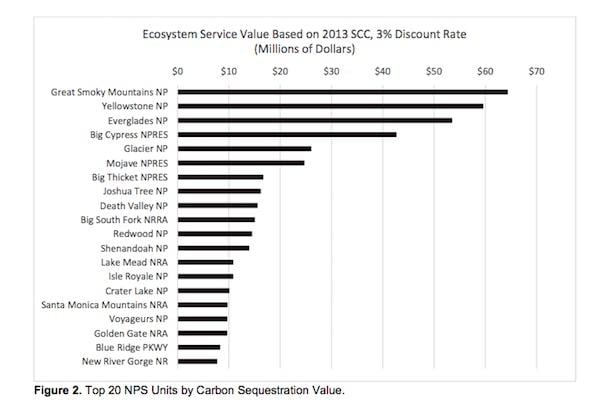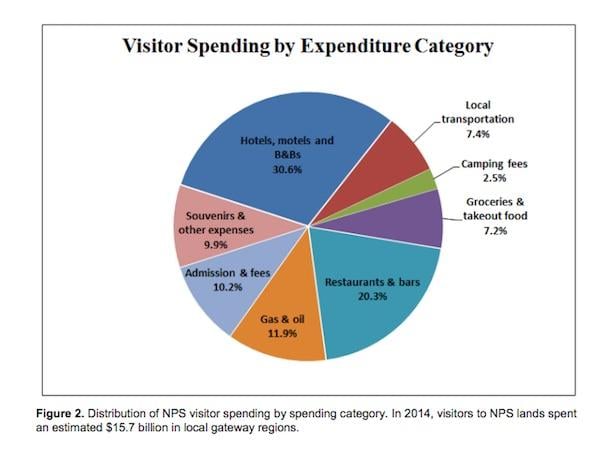Top Interior Department and National Park Service officials used Earth Day to promote the National Park System as an economic engine with an annual output of $30 billion and which serves as a carbon sink with an additional value of nearly $600 million.
The report, released at 6 a.m. Eastern on Wednesday, comes at the mid-point of National Park Week and as the National Park Service builds on its campaign to mark its centennial in August 2016.
Along with touting the economic value of the park system, a clutch of accompanying reports pointed to $26 million in improvements to parks from coast to coast, the president's "Every Kid in a Park" initiative that will see 4th graders this fall receive an annual parks pass, and the "Find Your Park" campaign to connect all Americans to the country's system of public parks and recreation lands.
In 2014, the National Park System received over 292 million recreation visits. NPS visitors spent $15.7 billion in local gateway regions (defined as communities within 60 miles of a park). The contribution of this spending to the national economy was 277 thousand jobs, $10.3 billion in labor income, $17.1 billion in value added, and $29.7 billion in output. The lodging sector saw the highest direct contributions with 48 thousand jobs and $4.8 billion in output directly contributed to local gateway economies nationally. The sector with the next greatest direct contributions was restaurants and bars, with 60 thousand jobs and $3.2 billion in output directly contributed to local gateway economies nationally.
In a prepared statement, Interior Secretary Sally Jewell said the economic data underscore that, 'Our national parks often serve as economic engines for local communities, drawing tourists from around the world who pump money into area stores, restaurants, hotels and more. At the same time, these treasured landscapes have shown they support strong public health by absorbing carbon pollution that contributes to climate change. When we invest in our parks, we're not only preserving our natural and historic sites, we're supporting strong economic growth and healthier communities.'
Gateway communities to the parks were a large benefactor of this spending, as motels and hotels in those communities received $9.5 billion in business from park visitors, while commercial campgrounds in those communities saw $922 million in business, according to the economic report.
The economic news was welcomed by the National Park Hospitality Association, which represents national park concessionaires.
'We applaud NPS efforts to describe the importance of park visits to regional and national economies ' it is significant, indeed," said Derrick Crandall, the association's counselor, in an email. "Even beyond the important figures contained in the report, national parks play an important role in prompting purchases of recreational equipment well beyond the 60-mile region around parks ' including major goods like RVs and boats and clothing. We also note that this report does not assess the value of our parks on inbound tourism to the United States ' a major and growing positive influence on our national economy.
'Best of all, the economic value of national parks to the nation can be enhanced without threats to the natural, cultural and historic resources of park units with management changes like longer operating hours and seasons and investment in appropriate visitor facilities designed to be low impact and efficient to operate.'
The news was also welcomed at the National Parks Conservation Association, where Craig Obey, the group's senior vice president for government, noted that, "It's clear that when our national parks are a priority, our economy benefits. The $3 billion increase in economic impact over 2013 is because more people visited parks, parks and communities didn't suffer the negative impact of a federal government shutdown, and the sequester cuts to parks were temporarily addressed.
'We had a record-breaking number of visits to national parks in 2014, and even more visits are likely with the approaching park centennial. This is the time to permanently end the sequester, reverse annual funding shortfalls, and fix park infrastructure with a pro-park transportation bill," he added in a prepared statement.
The report noted that its figures were best estimates based on various models, and that were likely over-estimated in some areas, and under-estimated in others.
As for parks serving as carbon dioxide sinks, the press release said, "Scientists found that 78 percent of the parks studied functioned as net carbon sinks, meaning that more CO2 is stored, or sequestered, than is released. Great Smoky Mountains National Park stored the largest amount of CO2, 1.6 million metric tons, valued at $64.4 million, each year."
"...in aggregate, NPS lands in the conterminous United States are a net carbon sink, sequestering more than 14.8 million metric tons of carbon dioxide annually. The associated societal value of this service is estimated at approximately $582.5 million per year," the report added.





Comments
Michael,
At first I thought your objection was to damming in general. As our discussion has progressed I have realized your issue is more with the Glen Canyon Dam in particular. As I understand, you deem it redundant since Mead will never be filled.
I will admit I don't know enough about either of those bodies of water or their watersheds to decide if that is true or not. However, given how wrong climate predictions have been (remember the ice age predictions of the 70s) I don't know that I am ready to declare we will never need/want, Glen Canyon Dam in the future. And certainly not based on a supposed 14 year drought. I must say where I live in the Colorado River headwaters, the precipitation has been pretty darn good the last few years.
I would also note, I know far more people that like Lake Powell as a lake than want it to be returned to a dry canyon.
But, keep the data coming, I am always willing to learn.
No none has mentioned the fact that both Lakes Powell and Mead evaporate enough water every day of the summer to supply the needs of Las Vegas or Los Angeles for a day. In addition, the evaporation leaves behind water so saline by the time it reaches Yuma that farmers find their fields being slowly destroyed by saltation.
What was that slogan that was so popular a few years ago? Something about It Ain't Nice To Fool Mother Nature.
Yup. But we keep trying.
Yes, Michael, I do agree. As "Where Did the Colorado Go?" makes clear, Lake Powell exists principally to distribute the water downstream, a role that was never really "necessary." You have my support in bypassing the dam, of course. I was simply making the point that with or without it, the problem of "living" in a desert persists. Eventually, climate change or not, a drought would come along that would repeat the past. We do appear to be "rebuilding" such a drought. Meanwhile, I applaud any effort to restore these magnificent canyons--as well as Grand Canyon itself. Now, aren't we glad we had David Brower? May he (and Edward Abbey) rest in peace.
Nice post Alfred, there are still many trying to educate citizens for the need for conservation, family planning, you name it. It is a tough nut to crack, even the issue of banning plastic water bottles in National Parks is seen as inconvenient or worse. Small steps taken can add up to big ones, many communities here in California are now banning the use of plastic shopping bags in markets, etc., it works. The town my son resides in is one such area, you learn to take your recyclable bags with you or be prepared to buy one at the store. It is no big deal. Fifty plus thousand residents of this town are doing it.
I agree, the issue of population and the pressure for growth to accommodate it is challenging. Many citizens are working hard for women empowerment and equality. Family planning (sex education), is on every educators agenda. many obstacles to overcome, but there have been some areas of success. Interestingly enough, there are still many political leaders calling for less government intrusion in peoples lives, but are only to eager to legislate mandates on a women's right to make her own reproductive health care decisions. Please excuse, getting off topic, an interesting discussion.
Works doing what? What does it accomplish? Food poisoning?
http://www.huffingtonpost.com/2013/02/07/plastic-bag-ban_n_2641430.html
EC,
Thanks. will do.